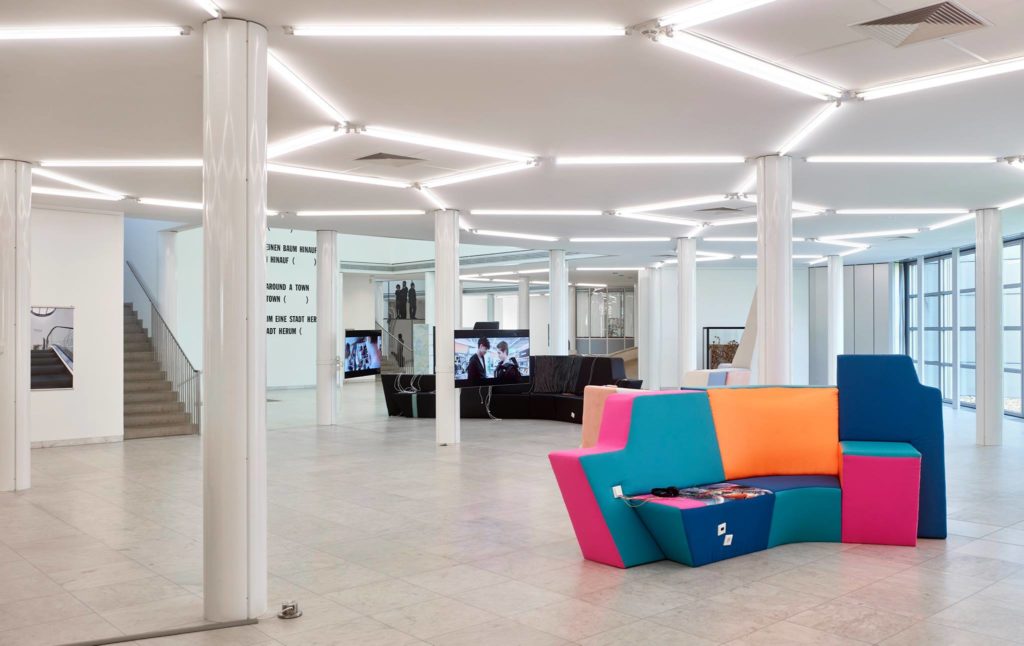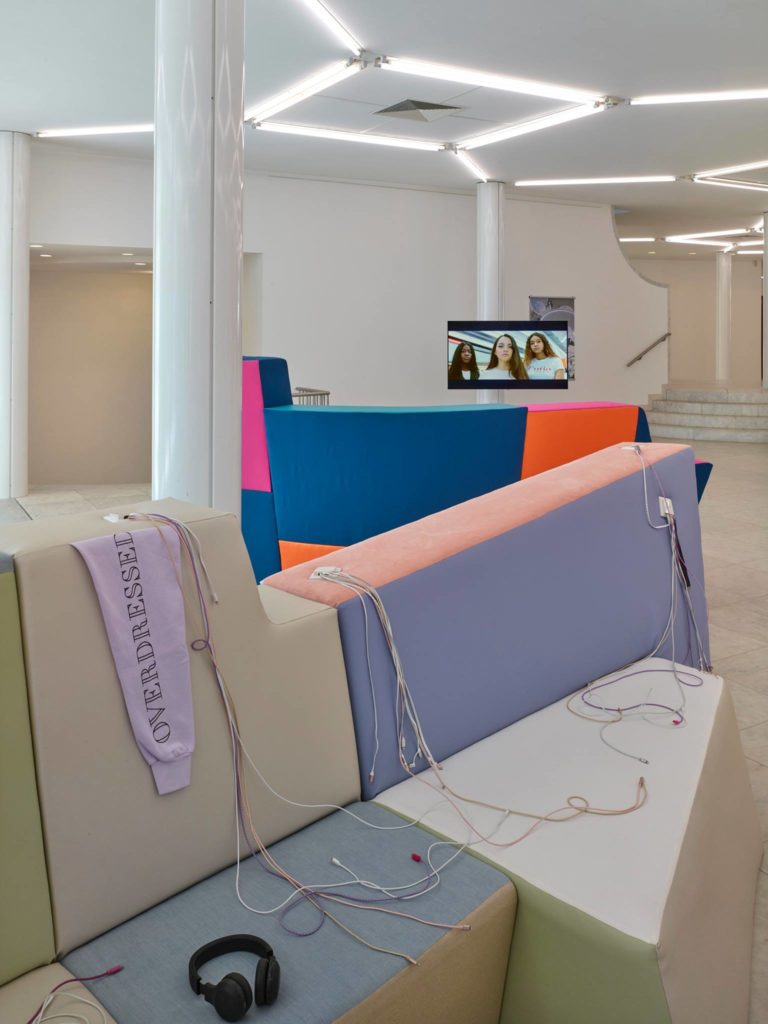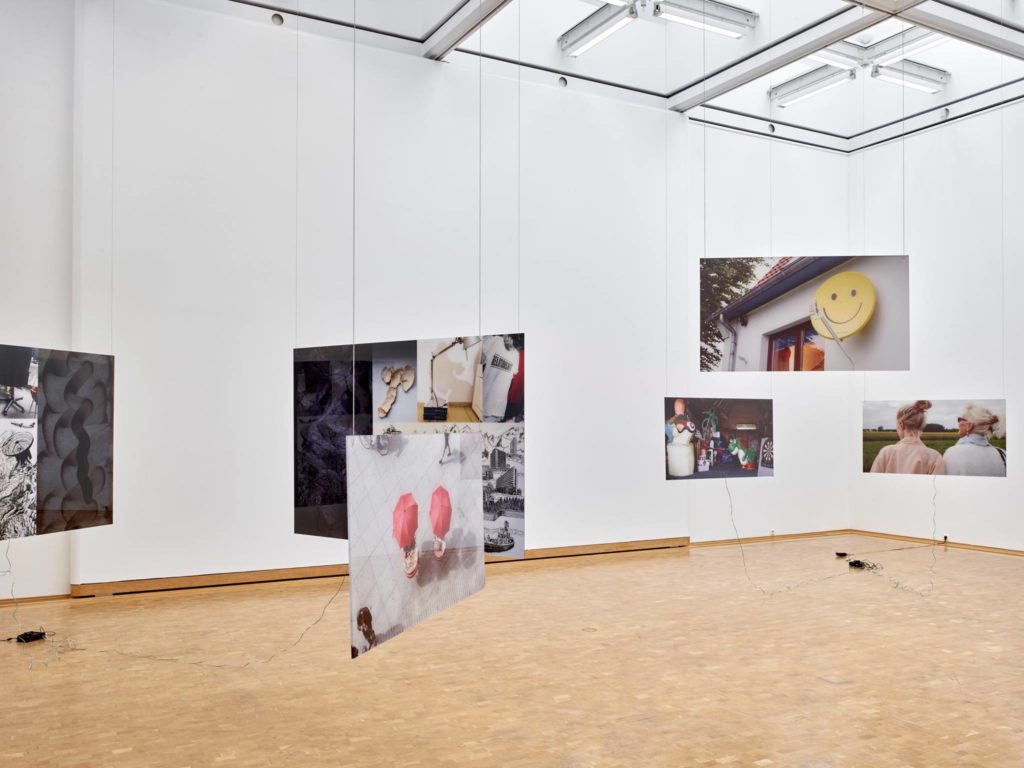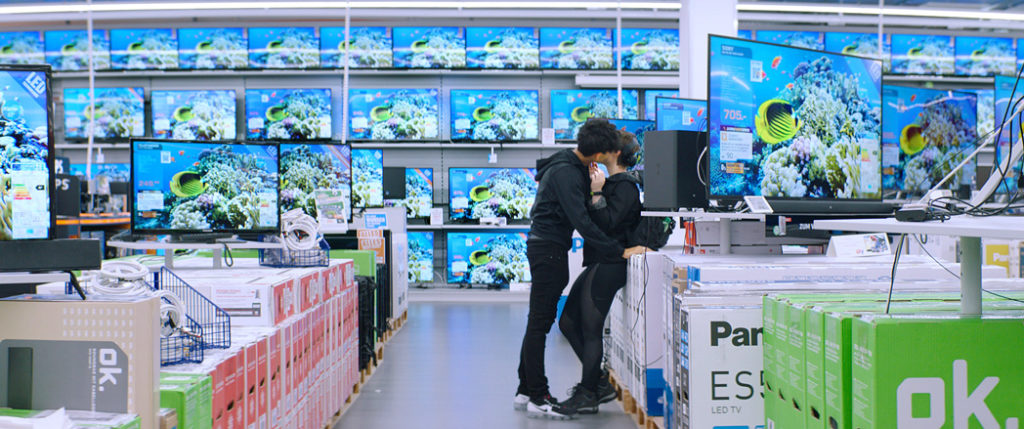Opened in 2014, Minto is self-consciously a destination. From the colourful frontage on the high street, to the eerily futuristic lighting schemes and furniture along the walkways, it exists as much as a visual object as a retail space. Britta Thie’s new film, Power Banks, is a kind of magical-realist fantasia set inside the capitalist-surrealist environment of this shopping mall in the Rhineland city of Mönchengladbach. It follows the events (and non-events) in the lives of a group of local teens as cliques collide and tentative romance burgeons. Thie’s previous work, Translantics, was a web series focussing on the lives of arty millennial types as they drift between cities and disappointments. Power Banks similarly explores youth, ennui, cultural positioning and performativity; except, instead of following globe-trotting bright(ish) young things, all the action takes place in the interior of Mönchengladbach’s retail cathedral and centres on kids from the city itself.

The day I found myself on Minto’s rooftop dining area, I was having falafel and Mediterranean salads with Berlin-based artist Thie and the director of the Museum Abteiberg, Susanne Titz, to discuss the Power Banks exhibition, that had recently opened in the nearby gallery. From this vantage point, you can see the residents of the town as they make their way along the vertiginous high street, some continuing up toward the historic Altmarkt, some curving off and disappearing toward the town’s high school. Many vanish beneath the edge of the terrace into the mall itself. Shopping malls have always had a curiously important place as cultural artefacts since their late 1980s heyday. Now in a kind of Götterdämmerung period for these once favoured retail spaces, their meaning is shifting, but their status as sites of cultural import remains. In an age defined increasingly by e-commerce and dominant net-based mega corporations, Thie’s work explores the role of the shopping centre as a physical space. If one constructs a retail palace but people opt to shop online, what is its purpose, and, importantly, what does it mean as a site in its own right and as a visual context in which individual narratives are constructed and performed?
Thie found herself particularly interested in the way the local teens repurposed the mall to their own ends. “The teenagers acted like pirates in a way,” she says, noting that those that gather and meet there don’t spend a lot of time making purchases: Minto may exist to sell things but as the teens she observed demonstrated, the capacity to detourn such dynamics is part of its appeal. Power Banks is remarkable for its headlong dive into this unpredictable network of intentions, not least as the film is set in a branch of Saturn — one of Germany’s most recognisable and ubiquitous consumer electronics retailers. Walking me through the gestation and origin of the work, Thie talks about the relationship between commerce, individuals, and self-presentation as manifested in a commercial space and the challenges of making a work in such a context without simply ending up creating a very arty commercial.

**Could you describe what you got you interested in the shopping mall as a location to begin with?
BT: When I first walked into the city of Mönchengladbach, I immediately noticed this alienesque object in the city that was somehow bulging out of every street corner, like some cake topping gone wrong. It also reminded me a little bit of the spaceships in Independence Day that hover really close above the city, just that this one seemed to be LARPing a friendly commerce-comrade for it.
You can’t really avoid this mall when you walk into the center of the town, so I passed through it when walking from the train station to the Museum for my first research trip. I noticed that inside were these lounge-like sofas with electrical outlets to charge your phone. It felt like an approach to make it more ‘fancy’ and a ‘comfy’ place. Those benches were mainly populated by teenagers. Walking through the different levels, it felt like a remake of Westside Story in the way the teens were huddling together in different groups that each clearly had their own significant dress codes. But it also had a bit of the vibe of The Truman Show. This hermetic bubble that reminded me of the ‘filter bubble’ and the dome in Truman Show. But [the mall] also has a ‘digital backyard’. I went on the location tag of the mall and found all those stories of the kids. They were watching and broadcasting themselves constantly.
**You noted how the furniture was of interest to you specifically, could you speak about why?

BT: Basically, the topic of puberty is something that interests me and these benches are going through their own puberty, kind of transcending between spaces. I contacted the interior designers of the mall to tell them that I was interested in their designs and asked if they could imagine that I do something more with them. They were really excited about it, like there was no fear of, “oh no, she’s mocking us”. They were super happy to collaborate. I made these PhotoShop collages of photos of the benches I had taken, with or without teenagers on them. It was interesting how the teenagers kind of acted like pirates in a way, non consuming. I think they tried to copy-paste fancy Düsseldorf upper-middle class offers into Mönchengladbach but there isn’t that audience. The only people who really go there a lot are these kids. but they kind of go there in different cliques and don’t consume. They try on clothes in H&M and tag the mall, and they’re not making fun of it, but they’re just kind of using this space for their own fictionalisations as a backdrop and that fascinated me, these hour long sit-ins on the furniture drinking one smoothie.
**How does the interaction of the space itself and the creative product of posting images or texts within that space interest you as an artist?
BT: I think it was this kind of playful approach. Young people just take what’s there and I really liked that. It felt like there was a pre-scripted reality happening already when I went on the location tag of the mall. It felt almost like an Advent calendar, like Instagram Stories as Advent calendar doors that you open and there’s this whole narrative behind them. You have doors to people’s lives. I started to chat with some of them on Instagram and invited them to the museum to find out what they would be thinking if another layer of fiction would be added to it. What would they think if I wrote a film script based on Instagram stories that I saw? They were really excited about it.

The last thing that I wanted to do was some kind of a voyeuristic angle, to find some subculture and just hop on to it. I didn’t want to parasitically look at what teenagers do there but to try to look with them and go with them through the ideas of the script somehow. Using the images and their slang, I started to write something, and then I got screenwriters into the mix to kind of engineer the dramaturgy of the film so that it’s a bit more like Netflix style because I didn’t want it to feel like an ‘art’ film. I wanted it to have the glossiness and surface attraction that a Netflix show would have.
**Your work frequently touches on the tropes of television, sitcoms in particular, could you speak about the way Power Banks continues to explore this area of interest?
BT: One idea that was very strongly embedded into the whole concept was that I show it in a place of commerce — in this case, the Saturn electronics store — and that it somehow becomes embedded into the framing. There are already all these trailers of Netflix shows at Saturn store screens and they’re edited between stock footage and weird infomercials. I thought it was interesting how my film materializes in this space. It was somewhat more accessible because it played in several electronics stores all over Germany, in all [Saturn] stores, actually, but it wasn’t much talked about. Somehow the press didn’t really get ahold of it.
**Did audiences notice or follow up?
BT: It was interesting, it showed me how important framing is. In comparison with Translantics — which was heavily promoted by the Kunsthalle and showed on ARTE — I didn’t have that framing. Of course, I had the help of Museum Abteilberg but it’s not as widely known as ARTE. I really kind of snuck the film into a TV broadcast in physical space and I got a lot of attention on Instagram where people were tagging me in different markets in Germany. [They were] ‘non-artworld people’; people who just kind of stumbled across it and saw it.

**How did they interpret it? Did they think it was an advert?
BT: They were like, ‘When does the film come out?’ Or, ‘Where can i see it?’ Or, “is this a pilot? I want to see the series’. It was communicated that it could be seen at Museum Abteilberg but people don’t know the name; people shopping at a Saturn in Leipzig, they don’t really know what the museum is, or about the place and they think of it as a TV show. It was very visible, but then kind of hard for people to put their finger on where the follow up was. It was an interesting experiment where it had an impact that was a little invisible or hard to show off. For a physical show, you have installation shots, and then maybe Artviewer posts it and there you go. This was more where I, as an artist, as my ego thing, I didn’t have much to do with it. It developed its own life and I liked that.
**Did working with a shopping mall and retail outlet ultimately reveal limitations of the gallery experience/space for you?
BT: For sure. I still don’t work with a commercial gallery. I feel like this weird in-between artist who exists between platforms like web series or performative spaces that materialise themselves in institutions but not so much like the classic gallery booth thing. It just always happens that I slide into these other worlds.

**Do you feel this project gave you any insight into why you work better in those peripheral spaces? As a result of a project that took place on this scale, involving Saturn, do you feel like it’s given you a window into your own creative practice?
BT: I feel I don’t have to navigate in certain terms or rhythms — like art fairs or anything — but that’s not what I think about when I do it, to be honest. It’s hard to answer. It interests me. The accessibility interests me. I was also obsessed with 90s television. I don’t want it to come off as just nostalgic but somehow comfort zones as a concept interests me; lounge situations that I’ve created in the museum with this furniture that is placed in an airport lounge but is in the museum. It was free entry for the kids in the museum. Free Wi-Fi. Free power. It was, in part, a drag-and-drop from the mall setting to the museum, which is like a few blocks up the hill. The museum itself is almost like a mall. It’s a 1982 Hans Hollein building so it feels very mall-ish. I’m very interested in these like, I don’t want to say ‘democratic’ but these ‘open pores of perception’. The skin needs to breathe…
**Galleries and malls are types of private spaces, essentially, and often they have a certain kind of person in mind who they address. This is true of digital spaces, too: they are corporate spaces that are publicly accessible. Did this project offer any insights for you into this dynamic, as there is always a sense of limitation or negotiation in these contexts, and when private locations become sites of a more widely distributed means of cultural production?

BT: At the time, when I conceptualised the show this really cool and interesting article by Dena Yago on e-flux came out. ‘Content Industrial Complex’ it was called. She’s writing about content and how malls and museums create these social media moments. It’s about content-creating: people become the content creator for the institution. I don’t want to run away from it and be scared of branding and that kind of thing, especially as with shopping malls. It was interesting the mall couldn’t just shut itself down and only be accessible for people who consume. It had to be open on Sundays and on holidays so people could pass through it, and I thought that was interesting.
**As you were working with a consumer goods company with Power Banks. In a sense, you’re using your brand and their brand at the same time, and there’s a tension. They understand themselves to be getting something from you, and vice versa. How does one get what one wants without consuming the other’s brand? In one sense, maybe that’s the story of art. Every time you make something public, there’s another agenda involved but that takes place at another level. Where are the limitations and opportunities of what art presented in this way can explore?
BT: This was a very interesting part of this whole production, how to get Saturn to show the piece.
**And it was specifically Saturn you wanted to work with?

BT: It was the shop in the mall. Geographically and logically it made sense, and then it felt almost like a LARP to go into these meetings. I had a meeting with my production company, Senator Films, who supported the project. I met the CEO of Saturn Deutschland in Munich in their headquarters in this tower. I was led into this conference room and it was a pitching performance. This whole thing was so funny and strange and I didn’t get any money from them. I also wanted to stay independent of any branding. This way it was more my approach to have the product placement reverse engineered because my content is there and it just happens to be in this store. It takes place in the story but it never really advertises for [Saturn]. It’s kind of an inside-out logic.**













